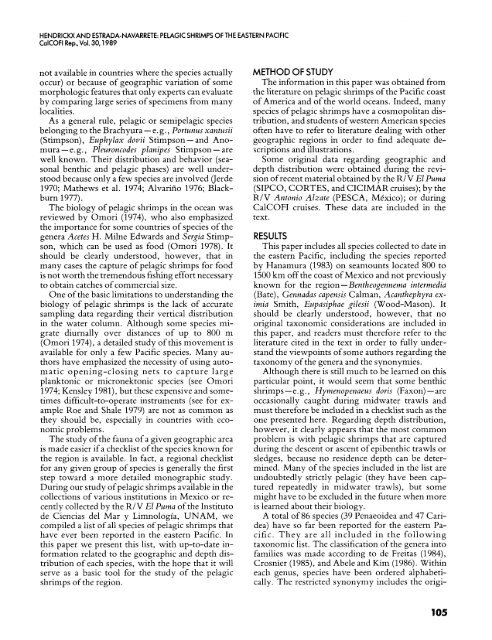CalCOFI Reports, Vol. 30, 1989 - California Cooperative Oceanic ...
CalCOFI Reports, Vol. 30, 1989 - California Cooperative Oceanic ...
CalCOFI Reports, Vol. 30, 1989 - California Cooperative Oceanic ...
Create successful ePaper yourself
Turn your PDF publications into a flip-book with our unique Google optimized e-Paper software.
HENDRICKX AND ESTRADA-NAVARRETE: PELAGIC SHRIMPS OF THE EASTERN PACIFIC<br />
ColCOFl Rep., <strong>Vol</strong>. <strong>30</strong>,<strong>1989</strong><br />
not available in countries where the species actually<br />
occur) or because of geographic variation of some<br />
morphologic features that only experts can evaluate<br />
by comparing large series of specimens from many<br />
localities.<br />
As a general rule, pelagic or semipelagic species<br />
belonging to the Brachyura - e. g., Portuntrs xantusii<br />
(Stimpson), Etrphylax dovii Stimpson - and Anomura<br />
-e. g., Pleuroncodes planipes Stimpson - are<br />
well known. Their distribution and behavior (seasonal<br />
benthic and pelagic phases) are well understood<br />
because only a few species are involved (Jerde<br />
1970; Mathews et al. 1974; Alvariiio 1976; Blackburn<br />
1977).<br />
The biology of pelagic shrimps in the ocean was<br />
reviewed by Omori (1974), who also emphasized<br />
the importance for some countries of species of the<br />
genera Acetes H. Milne Edwards and Sergia Stimpson,<br />
which can be used as food (Omori 1978). It<br />
should be clearly understood, however, that in<br />
many cases the capture of pelagic shrimps for food<br />
is not worth the tremendous fishing effort necessary<br />
to obtain catches of commercial size.<br />
One of the basic limitations to understanding the<br />
biology of pelagic shrimps is the lack of accurate<br />
sampling data regarding their vertical distribution<br />
in the water column. Although some species migrate<br />
diurnally over distances of up to 800 m<br />
(Omori 1974), a detailed study of this movement is<br />
available for only a few Pacific species. Many authors<br />
have emphasized the necessity of using automatic<br />
opening-closing nets to capture large<br />
planktonic or micronektonic species (see Omori<br />
1974; Kensley 1981), but these expensive and sometimes<br />
difficult-to-operate instruments (see for example<br />
Roe and Shale 1979) are not as common as<br />
they should be, especially in countries with economic<br />
problems.<br />
The study of the fauna of a given geographic area<br />
is made easier if a checklist of the species known for<br />
the region is available. In fact, a regional checklist<br />
for any given group of species is generally the first<br />
step toward a more detailed monographic study.<br />
During our study of pelagic shrimps available in the<br />
collections of various institutions in Mexico or recently<br />
collected by the R/V El Puma of the Instituto<br />
de Ciencias del Mar y Limnologia, UNAM, we<br />
compiled a list of all species of pelagic shrimps that<br />
have ever been reported in the eastern Pacific. In<br />
this paper we present this list, with up-to-date information<br />
related to the geographic and depth distribution<br />
of each species, with the hope that it will<br />
serve as a basic tool for the study of the pelagic<br />
shrimps of the region.<br />
METHOD OF STUDY<br />
The information in this paper was obtained from<br />
the literature on pelagic shrimps of the Pacific coast<br />
of America and of the world oceans. Indeed, many<br />
species of pelagic shrimps have a cosmopolitan distribution,<br />
and students of western American species<br />
often have to refer to literature dealing with other<br />
geographic regions in order to find adequate descriptions<br />
and illustrations.<br />
Some original data regarding geographic and<br />
depth distribution were obtained during the revision<br />
ofrecent material obtained by the R/V El Puma<br />
(SIPCO, CORTES, and CICIMAR cruises); by the<br />
R/V Antonio Alzate (PESCA, MCxico); or during<br />
<strong>CalCOFI</strong> cruises. These data are included in the<br />
text.<br />
RESULTS<br />
This paper includes all species collected to date in<br />
the eastern Pacific, including the species reported<br />
by Hanamura (1983) on seamounts located 800 to<br />
1500 km off the coast of Mexico and not previously<br />
known for the region - Bentheogennema intermedia<br />
(Bate), Gennadas capensis Calman, Acanthephyra eximia<br />
Smith, Etpsiphae gilesii (Wood-Mason). It<br />
should be clearly understood, however, that no<br />
original taxonomic considerations are included in<br />
this paper, and readers must therefore refer to the<br />
literature cited in the text in order to fully understand<br />
the viewpoints of some authors regarding the<br />
taxonomy of the genera and the synonymies.<br />
Although there is still much to be learned on this<br />
particular point, it would seem that some benthic<br />
shrimps-e.g., Hymenopenaeus dovis (Faxon) -are<br />
occasionally caught during midwater trawls and<br />
must therefore be included in a checklist such as the<br />
one presented here. Regarding depth distribution,<br />
however, it clearly appears that the most common<br />
problem is with pelagic shrimps that are captured<br />
during the descent or ascent of epibenthic trawls or<br />
sledges, because no residence depth can be determined.<br />
Many of the species included in the list are<br />
undoubtedly strictly pelagic (they have been captured<br />
repeatedly in midwater trawls), but some<br />
might have to be excluded in the future when more<br />
is learned about their biology.<br />
A total of 86 species (39 Penaeoidea and 47 Caridea)<br />
have so far been reported for the eastern Pacific.<br />
They are all included in the following<br />
taxonomic list. The classification of the genera into<br />
families was made according to de Freitas (1984),<br />
Crosnier (1985), and Abele and Kim (1986). Within<br />
each genus, species have been ordered alphabetically.<br />
The restricted synonymy includes the origi-<br />
105















